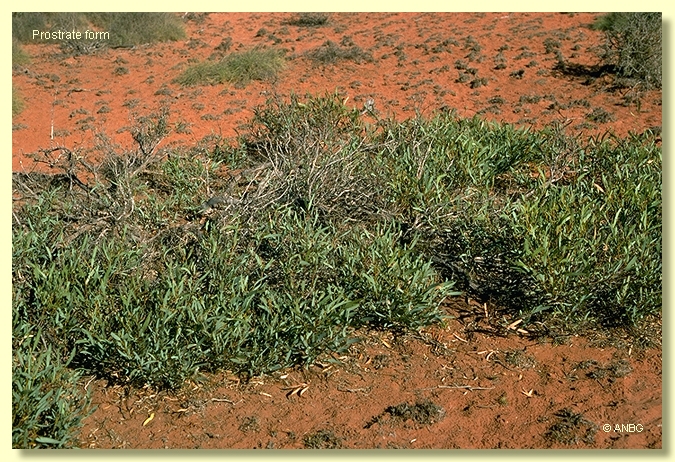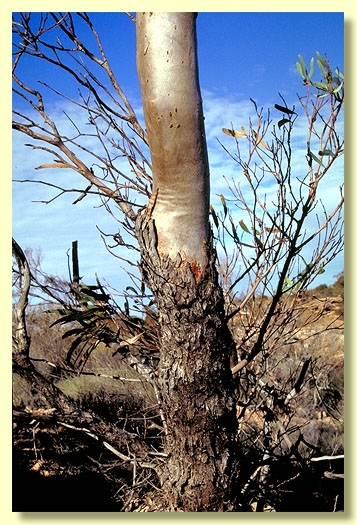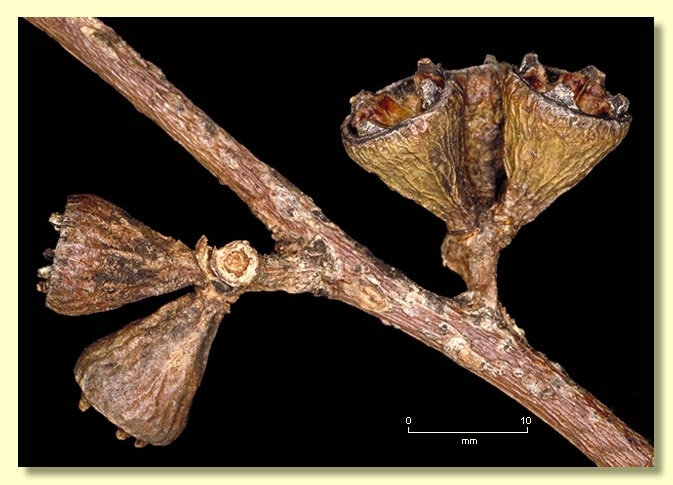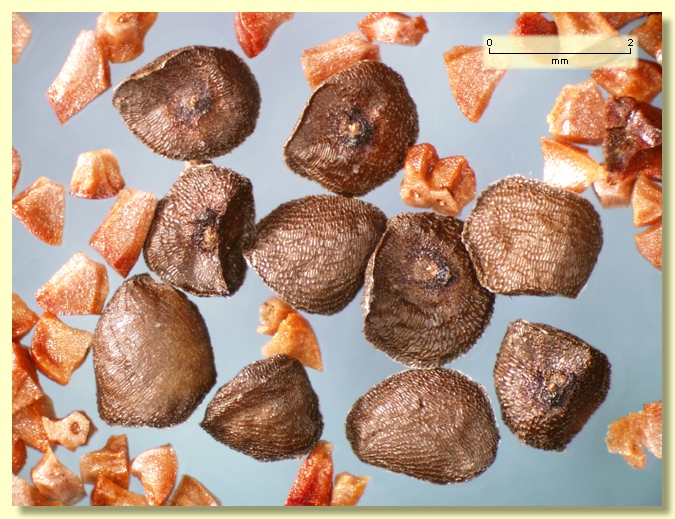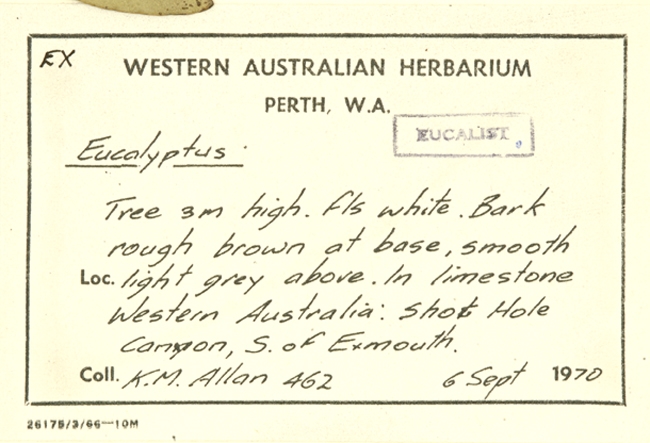Eucalyptus | Symphyomyrtus | Bisectae | Glandulosae | Accedentes
Euclid - Online edition
Eucalyptus prominens
Bark sometimes fibrous at the base to 0.5 m, more usually wholly smooth and grey to pinkish-grey to greenish-brown.
Branchlets have oil glands in the pith.
Juvenile growth (coppice or field seedlings to 50 cm): stems round to square in cross-section, not glaucous; juvenile leaves alternate, sessile to shortly petiolate, narrowly lanceolate, 5.5–8 cm long, 1.2–2 cm wide, base tapering to the petiole, apex acute, green.
Adult leaves alternate, petioles 0.5–1.3 cm long; blade lanceolate to narrowly lanceolate, 8–14.5 cm long, 0.7–2.2 cm wide, base tapering to petiole, concolorous, glossy green, side-veins at an acute or wider angle to midrib, reticulation sparse to moderate, intramarginal vein present, oil glands mostly island.
Inflorescence axillary single, peduncles stout and angular, 0.1–1.2 cm long, buds 7 or 9 per umbel. Mature buds obovoid to ovoid (0.7–1.1 cm long, 0.5–0.8 cm wide), sessile to shortly pedicellate (pedicels 0–0.4 cm long), operculum rounded, stamens irregularly flexed, anthers oblong, versatile, dehiscing by longitudinal slits (non-confluent), style long, stigma blunt, locules usually 4 or 5, the ovules arranged in 4 or rarely 6 distinct vertical rows on the placentae. Flowers white.
Fruit sessile to pedicellate, pedicels 0–0.5 cm long, obconical, 0.6–1.1 cm long, 0.7–1 cm wide, disc descending obliquely or vertically, valves 4 or 5, usually exserted, or sometimes only to rim level.
Seeds dull brown to grey, flattened-ovoid, 1.3–2.2 mm long, surface shallowly reticulate, hilum ventral.
Cultivated seedlings (measured at node 10): cotyledons Y-shaped (bisected); stems square to round in cross-section, not glaucous, leaves at the lower nodes sessile to shortly petiolate and opposite, lanceolate and up to 1.2 cm wide, narrowing above node six and becoming alternate, petiolate, linear to narrowly lanceolate, 5–12 cm long, 0.3–0.9 cm wide, dull to slightly glossy grey-green to green, apex acute, base tapering to the petiole. The change from lanceolate to linear leaves is dramatic in some seedlings, less so in others but still obvious.
Flowering has been recorded in August, September and October.
A mallee restricted to the limestone hills and eroded valleys of the Cape Range west of Exmouth Gulf. E. prominens has smooth or shortly rough-butted stems and long, narrowly lanceolate very glossy green leaves, obovoid buds in axillary clusters and obconical fruit.
Eucalyptus prominens is closely related to E. baiophylla, a species that was until recently included in it. E. baiophylla is a rough-barked mallee of procumbent to upright habit occurring on lowland sites south from Giralia near Exmouth Gulf to Warroora south of Coral Bay, on sandy soils with limestone gravel in the profile. E. prominens differs from E. baiophylla in having longer and wider adult leaves (4.7–9.8 cm long and 0.4–1.0 cm wide in E. baiophylla cf 8–14.5 cm long and 0.7–2.2 cm wide in E. prominens) and little or no rough bark. Another related Western Australian endemic coastal species is E. zopherophloia which occurs from near Jurien north to Tamala near Shark Bay and has fruit with valves consistently at or below rim level and ovate seedling and juvenile leaves (valves always slightly to boldly exserted and juvenile leaves more or less linear in both E. baiophylla and E. prominens). There are populations of low mallees on the Peron Peninsula (Shark Bay area) which are probably E. baiophylla (rather than E. zopherophloia) but further investigation is needed, particularly the growing of seedlings to check leaf shape.
Eucalyptus prominens is closely related to the widespread desert mallee E. trivalva and differs thus: four or five locular ovary (usually three or four in E. trivalva); the obconical fruit with much more prominent valves (usually cup-shaped to cylindrical to broadly obconical with valves enclosed or to rim level in E. trivalva); and seedlings with almost sessile leaves (always distinctly petiolate in E. trivalva). The buds of E. prominens are usually bigger than those of E. trivalva and have a shorter more rounded operculum.
On top of the Cape Range Eucalyptus prominens is usually associated with E. ultima and Corymbia terminalis. E. ultima can be easily distinguished by its much smaller fruit with needle valves (style remnants) well extended beyond the rim. C. terminalis is a bloodwood tree and can be distinguished easily by its tessellated rough bloodwood bark, terminal inflorescence and the leaf venation which has the secondary veins at a wide angle to the midrib, very dense reticulation and which lacks an intramarginal vein
Eucalyptus prominens belongs to Eucalyptus subgenus Symphyomyrtus section Bisectae subsection Glandulosae because the cotyledons are bisected, buds have an operculum scar and the branchlets have oil glands in the pith. Within this subsection, E. prominens belongs to a small subgroup of nine species, series Accedentes, further characterised by having buds with mostly inflexed stamens or some irregularly flexed (never erect), ovules in four (rarely six) rows and juvenile leaves petiolate. The species are E. accedens, E. laeliae, E. leprophloia, E. trivalvis, E. pruiniramis, E. zopherophloia, E. prominens, E. baiophylla and E. pilbarensis.
In previous editions of EUCLID E. prominens was stated to occur as far south as Kalbarri. Nicolle & Brooker (2008) when describing Eucalyptus baiophylla, a new species which they split from E. prominens as mwentioned above, also revised the concept of both E. prominens and the related but more southerly species E. zopherophloia extending the geographic range of the latter species north to include Kalbarri and Zuytdorp populations. In EUCLID we distinguish E. zopherophloia from the other two species by the following three features: E. zopherophloia has more extensive rough bark which may cover the entire trunk on taller mallees, juvenile leaves always wider (2.5-5 cm wide in E. zopherophloia, less than 2 cm in E. prominens and probably less than 1 cm in E. baiophylla (though this latter data for E. baiophylla is based on cultivated seedlings)), and thirdly bud clusters on peduncles only up to 0.3 cm long (may be up to ca 1 cm in the other two species).



